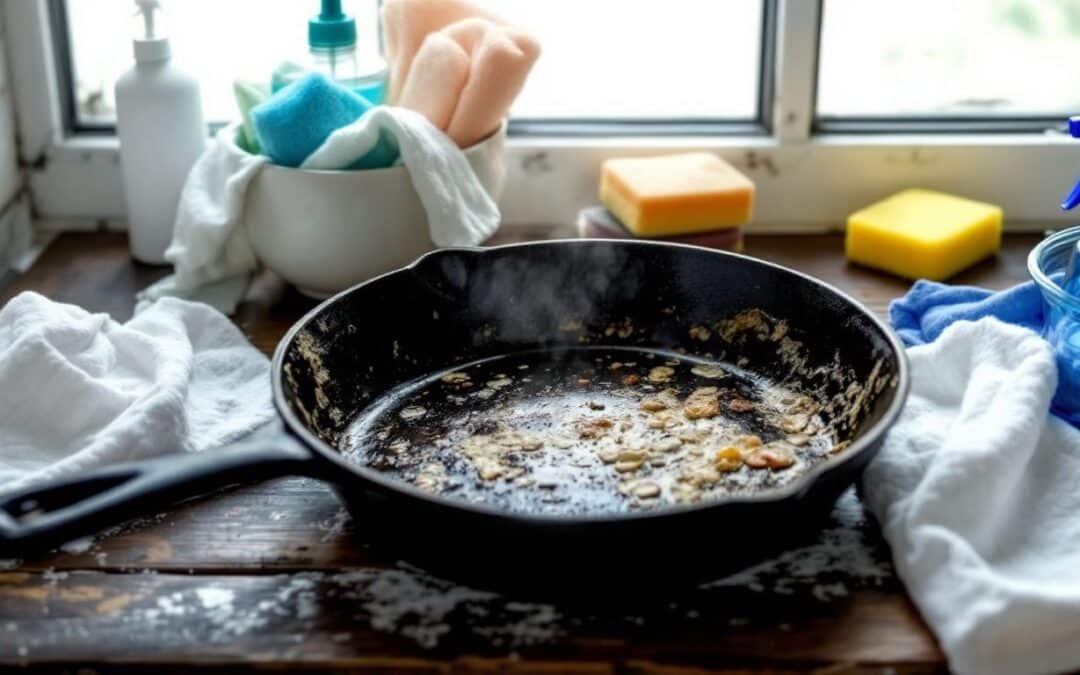Many people find it tough to clean cast iron skillets the right way. They might scrub too hard or not enough, leaving either scratches or leftover food bits. Washing a skillet by hand with a little dish soap is OK for keeping it clean.
This article will explain how to properly clean cast iron cookware. It covers everything from getting rid of stuck-on food to drying and oiling the pan for rust prevention. Get ready to make your skillet shine like new again.
Keep reading!
Key Takeaways
- Proper cleaning of cast iron skillets extends their lifespan and maintains the non-stick surface. Use a small amount of soap, warm water, and a pan scraper for routine cleaning.
- To prevent rust and preserve the seasoning, dry the skillet immediately after washing with a lint-free cloth then apply a thin layer of oil.
- For deep cleaning or restoring rusty skillets, soak in a vinegar solution, scrub off rust with steel wool or a chainmail scrubber, rinse well, dry thoroughly, and re-season by coating with oil and baking at high heat.
- Avoid common mistakes such as soaking in water for too long, using harsh detergents or metal scourers which can damage the skillet’s seasoning layer.
- Store cast iron cookware in a dry place with paper towels between them if stacked to prevent scratches and rust.
Why Proper Cleaning of Cast Iron Skillets Matters
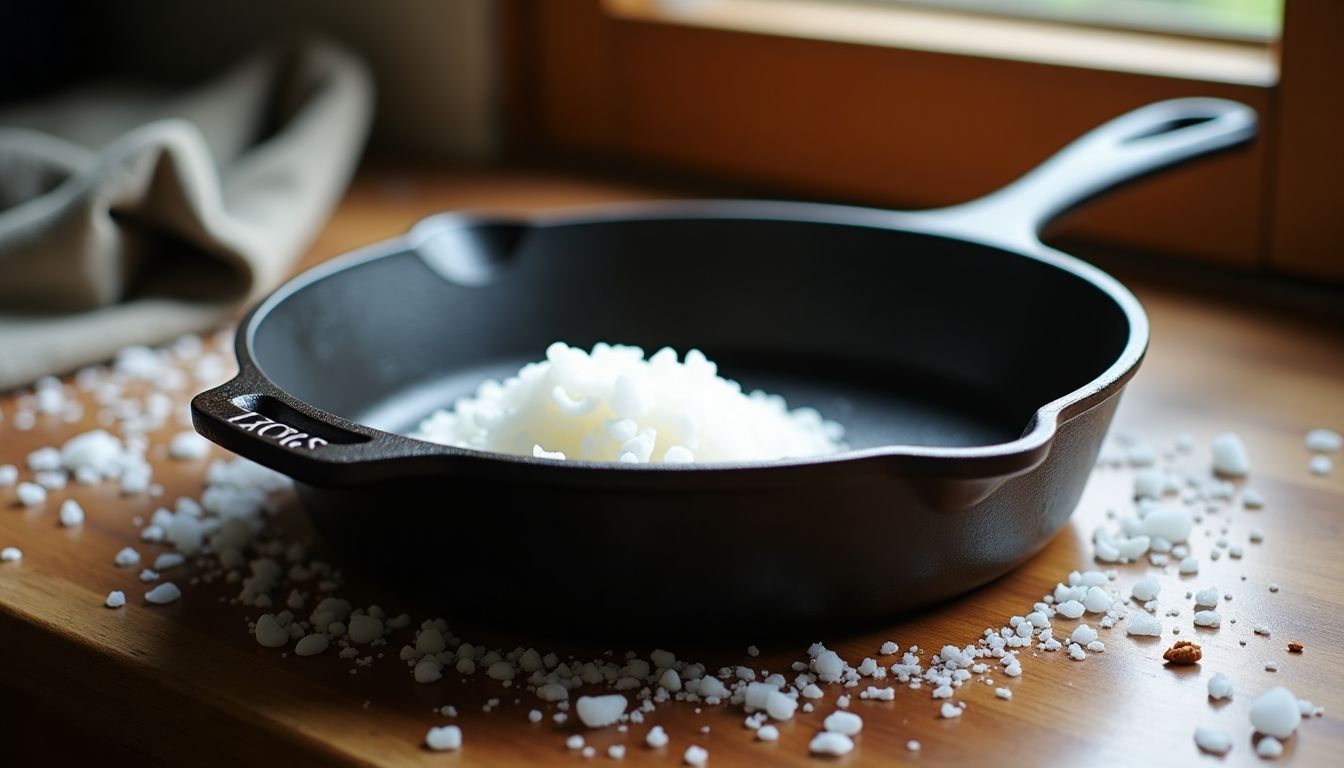
Shifting from laying down the basics, it’s significant to explain why maintaining cleanliness of cast iron pans is vital. Ensuring the appropriate cleaning of these skillets contributes to their efficacy and durability.
Papantoniou indicates that the method of cleaning using salt helps preserve the skillet’s patina. This technique helps maintain its high quality and lessens the frequency of reseasoning.
Regular usage of your skillet leads to accumulated food residues and could lead to burning if neglected. While the cooking fat can contribute to better taste and a natural non-stick feature, it might become stale without correct care.
Needless to say, one should avoid submerging in water or using a dishwasher; these strategies cause harm to the skillet’s structure. Aside from that, habitual cleaning can prevent rust formation, thereby ensuring your cookware stays in peak shape for many fruitful years.
Materials You’ll Need for Cleaning
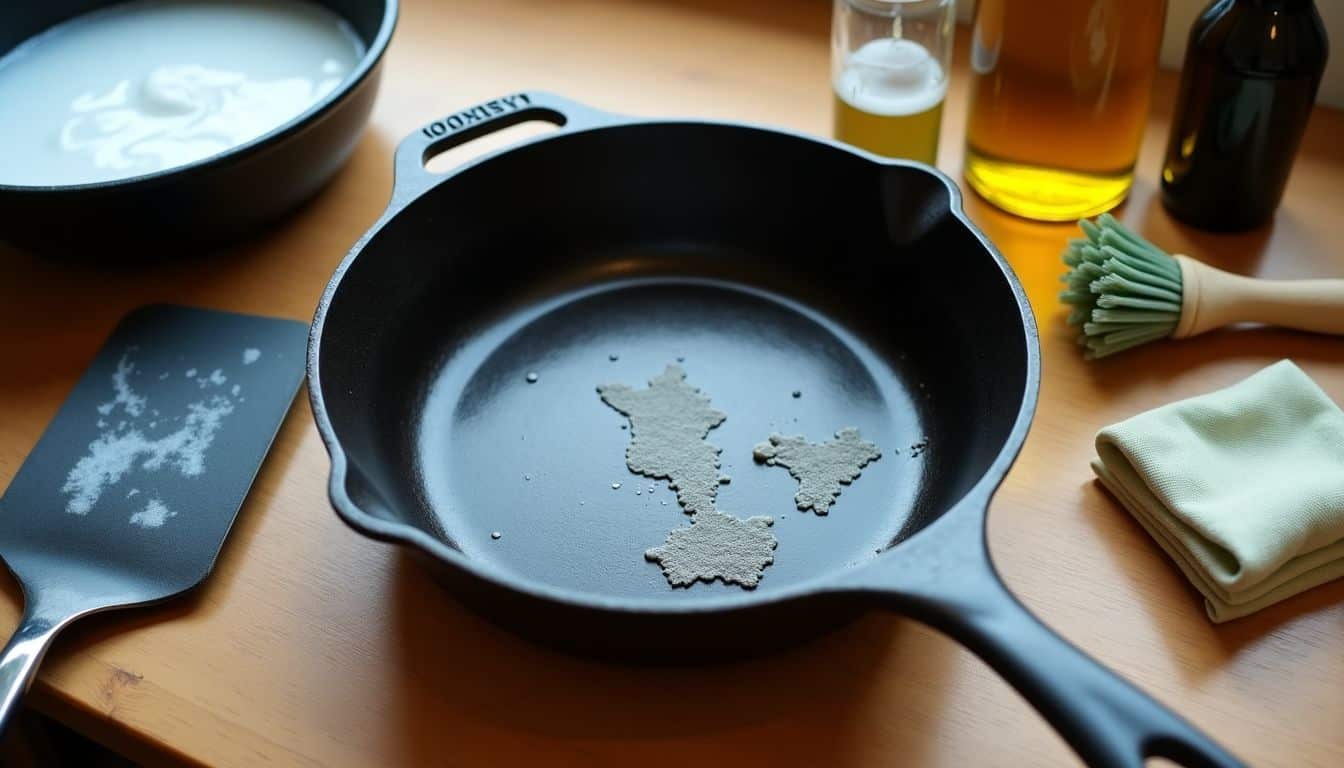
Cleaning a cast iron skillet properly keeps it in good shape for years. House owners and parents should gather the right materials before they start this easy task. Here’s what they need:
- A small amount of soap: Contrary to popular belief, using a bit of soap won’t harm a well-seasoned skillet.
- Pan scraper: This simple tool helps remove any stuck-on food without damaging the pan’s surface.
- Lint-free cloth or paper towel: They need something that won’t leave behind any residue for drying the skillet.
- Cooking oil or seasoning spray: Either canola oil, vegetable oil, or flaxseed oil works best for maintaining that nonstick surface.
- Nylon scrubbing brush: This is gentle enough not to scratch the cast iron but tough on food particles.
- Warm soapy water: They will use this sparingly to rinse the skillet after scraping off food bits.
Gathering these items ensures that house owners and parents have everything on hand to keep their cast iron cookware looking and performing its best.
Step-by-Step Guide to Cleaning a Cast Iron Skillet

To keep your cast iron skillet in top shape, follow a simple cleaning guide that includes scrubbing with warm water and drying it right away. Explore how easy maintaining this kitchen essential can be for more enjoyable cooking experiences.
Remove food debris
Wiping out food debris stands as the critical first move in cleansing your cast iron cookware. After cooking, grab a paper towel to clear away any loose bits from the surface. This step prevents leftover particles from sticking harder when you introduce water for further cleaning.
For those who dread damaging their pan’s seasoning, this method ensures you start on safe ground.
Next comes rinsing with warm water to float away any remaining bits clinging to the skillet. House owners should ensure they do not soak the pan, safeguarding against harm to its well-earned nonstick surface.
If some stubborn scraps refuse to leave, a gentle brush or scraper can be employed without harming the skillet’s precious seasoning layer. This tactic makes sure that your cast iron remains in top shape for its next culinary adventure.
Rinse with warm water
After removing food debris from your cast iron cookware, the next step involves rinsing it with warm water. Warm water works well to loosen any remaining bits of stuck-on food without harming the pan’s seasoning.
House owners and parents should ensure the water is not too hot, as extreme temperatures can damage cast iron over time.
For this process, hold the skillet under running warm water. Use your hands or a soft utensil to help remove any loose particles. Avoid soaking the skillet in water, as prolonged exposure can lead to rust formation.
This method ensures that your frying pan stays clean and ready for its next use while maintaining its nonstick surface.
Use a brush or scraper for stuck-on food
After rinsing the cast iron skillet with warm water, it’s necessary to address any persistent bits of food that didn’t release. A nylon brush or a pan scraper proves beneficial for this task.
Such implements are gentle enough not to impair the skillet’s surface yet stern on food remnants. For persisting areas, heating water in the pan for 3-5 minutes can help dislodge them, simplifying the scraping process.
It’s not recommended to use steel wool or metal scrubbers, as they can harm the seasoning on your skillet.
Jumping from nylon brushes to other cleaning tools like chainmail scrubbers when addressing very difficult residues can also achieve the desired outcome. Maintaining cleanliness of your cast iron cookware assures its durability and retains its nonstick quality without relying on harsh chemicals or severe materials that could degrade it.
Dry thoroughly to prevent rust
Drying a cast iron skillet right after washing it is crucial. House owners and parents should wipe it down with a lint-free towel immediately to stop rust from forming. This step keeps the cookware in top condition.
Towels that don’t leave behind tiny fibers are best for this job since they won’t stick to the surface of the pan.
The next move involves placing the skillet over low heat on a stove for about 5-10 minutes. Doing this makes sure any moisture that might have missed during wiping evaporates completely.
Such careful drying before re-oiling ensures that no rust can start and protects the seasoning, which is key to maintaining a nonstick surface on cast iron cookware.
How to Restore a Rusty Cast Iron Skillet
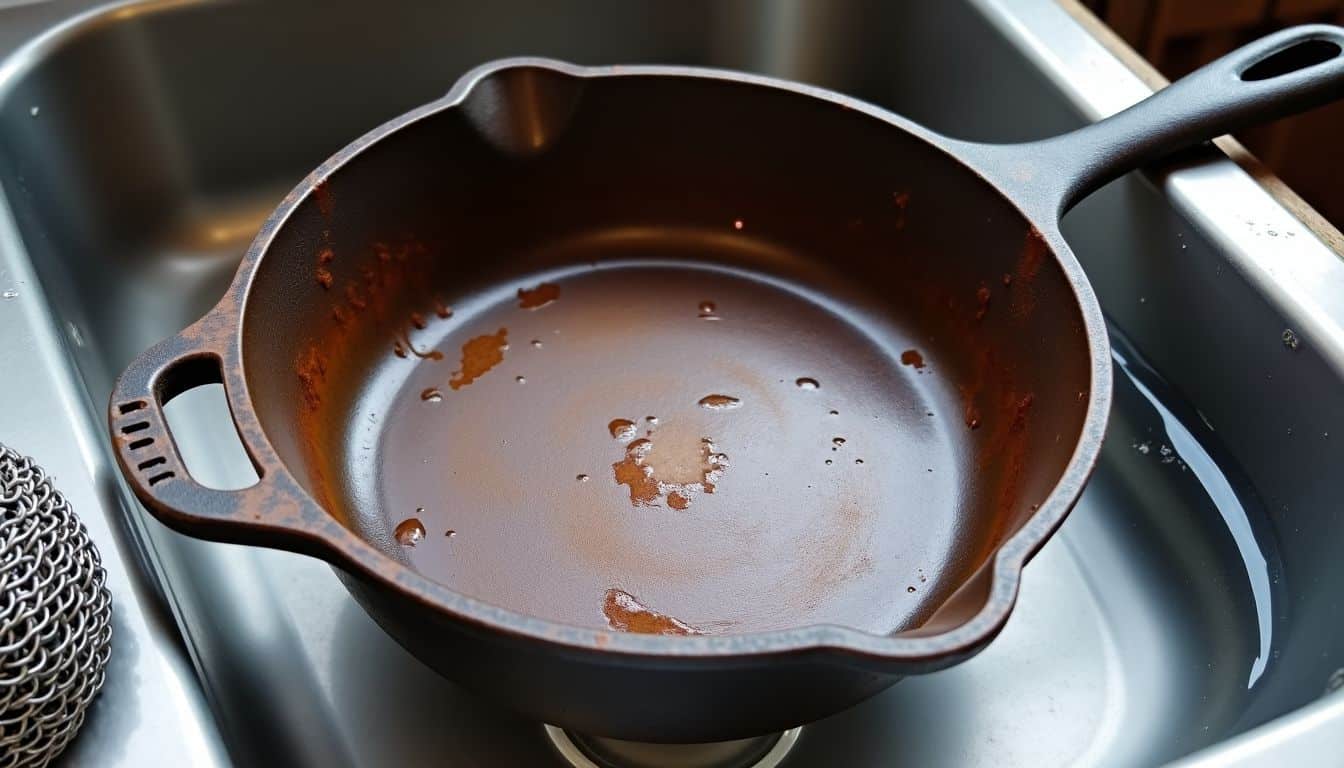
Restoring a rusty cast iron skillet makes it look like new and ready for more delicious meals. House owners and parents find this task rewarding as they bring life back to a durable kitchen tool. Here are the steps to restore a rusty cast iron pan:
- Identify the rust on the skillet. If the rust is just on the surface, restoration is easy. Deep pitting means it might be beyond saving.
- Mix equal parts of water and white vinegar in a large container. This mixture helps remove extensive rust without harsh chemicals.
- Submerge the rusty skillet in the vinegar solution. Let it soak for up to one hour, but check every 20 minutes to prevent damage.
- After soaking, scrub off loosened rust using steel wool or a chainmail scrubber. These tools are effective at removing rust without damaging the skillet’s surface.
- Rinse the skillet with hot water to wash away any remaining vinegar solution and loose rust bits.
- Dry the skillet immediately with paper towels or a clean cloth. This step prevents new rust from forming on the wet surface.
- Coat the pan lightly with vegetable oil or canola oil using a paper towel to protect and start re-seasoning its nonstick surface.
- Place aluminum foil on a baking sheet under the pan to catch drips, then put both in an oven preheated to between 450-500°F for an hour. The high heat further helps season and protect against future rust.
- Turn off the oven after an hour, leaving the skillet inside to cool down slowly with the oven.
These steps ensure that house owners and parents can successfully restore their cast iron cookware, extending its lifespan for many more years of cooking enjoyment.
Tips for Maintaining the Seasoning
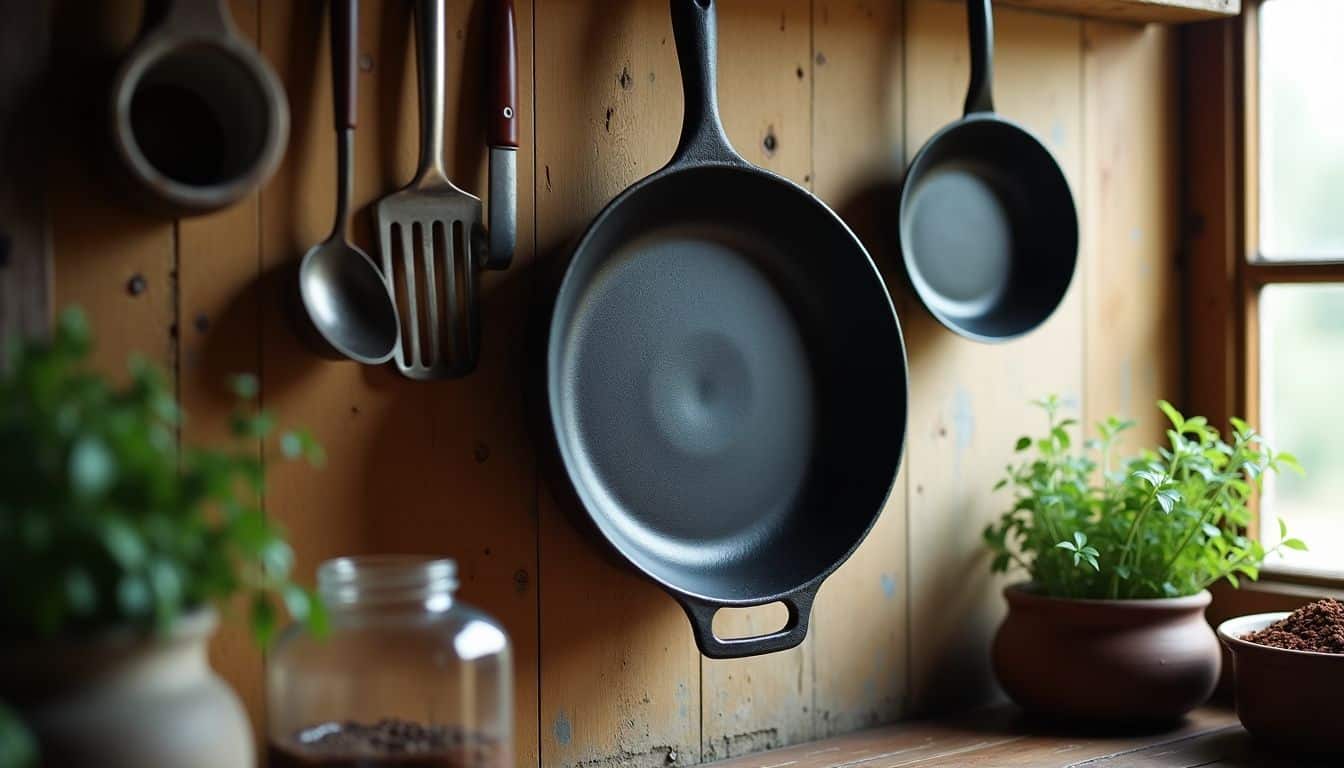
Maintaining the nonstick feature of your cast iron skillet seasoning is essential for its optimal use. Here are some tried-and-tested tips for preserving that desirable nonstick surface.
- Ensure to dry your skillet immediately after cleaning it with hot water. Employ a stove over low heat or an oven at 300°F for a few minutes to make certain all moisture disappears.
- Put on a slim layer of neutral oil, such as vegetable oil or canola oil, over the entire surface of the pan post each wash. Use a paper towel to distribute the oil evenly and wipe away any surplus.
- Try to limit cooking acidic foods like tomatoes and vinegar-based sauces in your cast iron cookware. These elements can gradually erode the seasoning.
- Consider using fats and oils whenever you utilize your cast iron pan. This habit prevents sticking and also contributes to the seasoning layer each time you cook.
- If you observe food starting to adhere or if there’s rust accumulation, reseason the skillet. Clean it thoroughly, then lightly coat it with flaxseed oil before placing it in a preheated 300°F oven for three or four hours.
- Keep your cast iron cookware in a dry location with a paper towel inside to soak up any moisture that might induce rust.
- For routine cleaning, consider coarse salt as a scrubbing agent in place of soap and water when feasible, as this technique helps preserve the seasoning without adding excess moisture.
- Keep away from using severe detergents and steel wool on seasoned surfaces; these can injure both the seasoning and the cast iron itself.
- Never let your skillet soak in water; even minor amounts of water left for a considerable period can result in rust and harm the seasoning you’ve strived to establish.
- In storage of numerous pans, positioning a layer of paper towels between them can avert scratches that could cause rust and damage to the seasoning.
Adhering to these measures assures that your cast iron skillet continues to be non-stick, rust-free, and prepared for countless delightful cooking endeavors.
Common Mistakes to Avoid When Cleaning Cast Iron
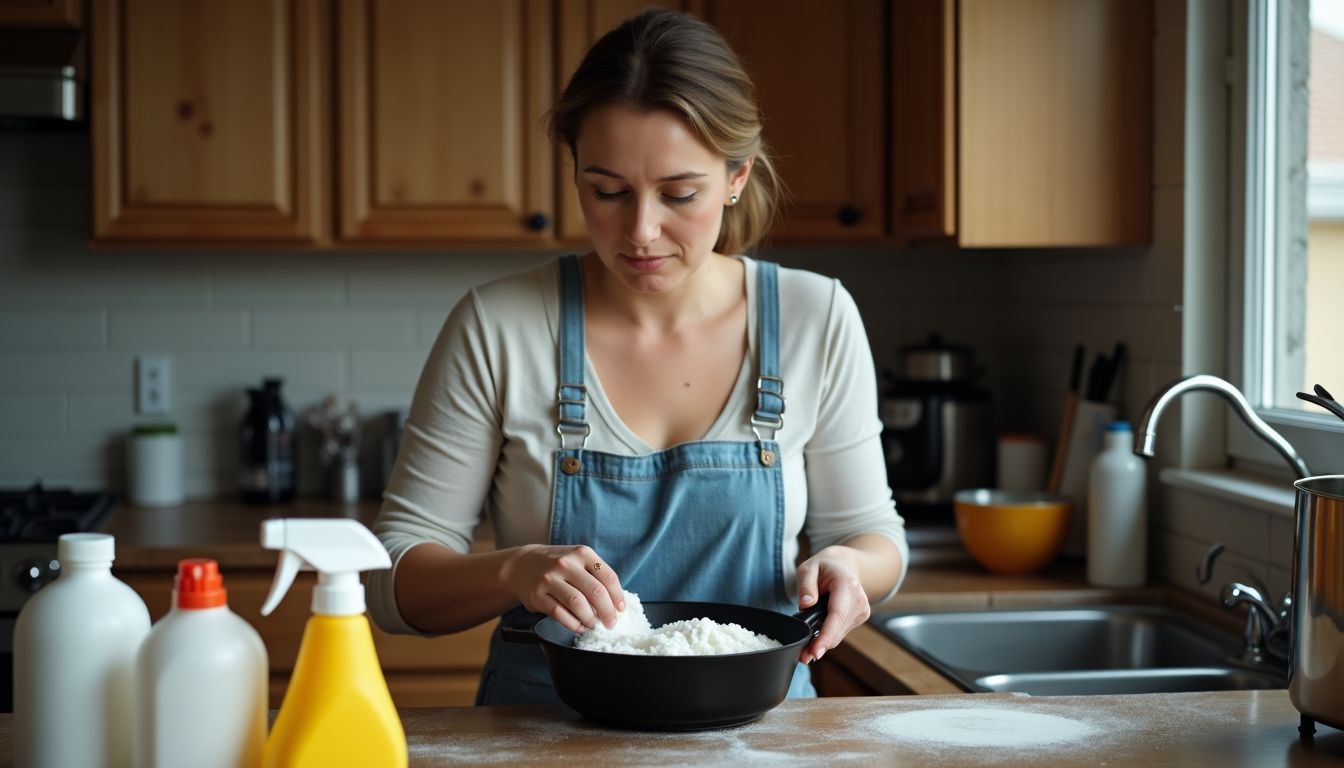
Cleaning cast iron skillets properly keeps them in top shape for cooking. House owners and parents should avoid common mistakes to maintain their cookware’s longevity.
- Soaking the skillet in water can cause rust.
- Putting it in the dishwasher strips away necessary oils.
- Using harsh detergents can damage the seasoning layer.
- Scrubbing with steel wool or metal scourers creates scratches.
- Forgetting to dry the pan completely leads to rust spots.
- Skipping re-seasoning after washing removes its non-stick qualities.
- Heating an empty skillet on high flame warps the metal over time.
- Cooking acidic foods too often erodes the seasoning faster.
- Using sharp utensils when cooking or cleaning scrapes off the protective layer.
- Storing food in the skillet may worsen its seasoning by absorbing flavors and moisture.
These steps ensure a cast iron skillet remains functional and efficient, keeping it ready for its next use without damage or wear from incorrect care practices.
Frequently Asked Questions

Owners often wonder about the right way to treat their cast iron cookware. Key queries include whether soap will harm the skillet and steps to take after an accidental soaking.
Can I use soap on my cast iron skillet?
You can indeed use soap on your cast iron skillet. Despite common fears, modern dish soaps are gentle and won’t harm your cookware’s surface. Lodge Cast Iron, a company with over 120 years of experience in making these skillets, confirms that cleaning them with soap is safe.
The key thing to avoid is strong cleaners like lye or sodium hydroxide as they can strip away the protective layer known as seasoning.
After buying a new cast iron skillet, washing it with soap before the first use prepares it for seasoning. Just apply a thin coat of vegetable oil afterward and heat it to start building up that nonstick layer.
Soap helps keep your skillet clean without damaging the hard work you put into maintaining its seasoning.
What should I do if I accidentally soak the skillet?
If someone accidentally leaves their cast iron skillet soaking in water, they must act fast to prevent damage. First, take the skillet out of the water as soon as possible. Quickly rinse it with hot water to remove any standing water.
Then grab a lint-free towel and dry the skillet thoroughly. If rust spots appear or if the non-stick surface seems compromised, they will need to re-season the pan. To do this, coat it lightly with vegetable oil or canola oil and heat it in an oven at 450 degrees for an hour.
Maintaining a cast iron’s seasoning layer is crucial for its performance and longevity. After drying the pan, applying a light layer of oil before storing it away helps protect its surface from moisture and prevents rusting.
Next, let’s explore how often one should season their cast iron cookware to keep it functioning like new.
How to Store a Cast Iron Skillet
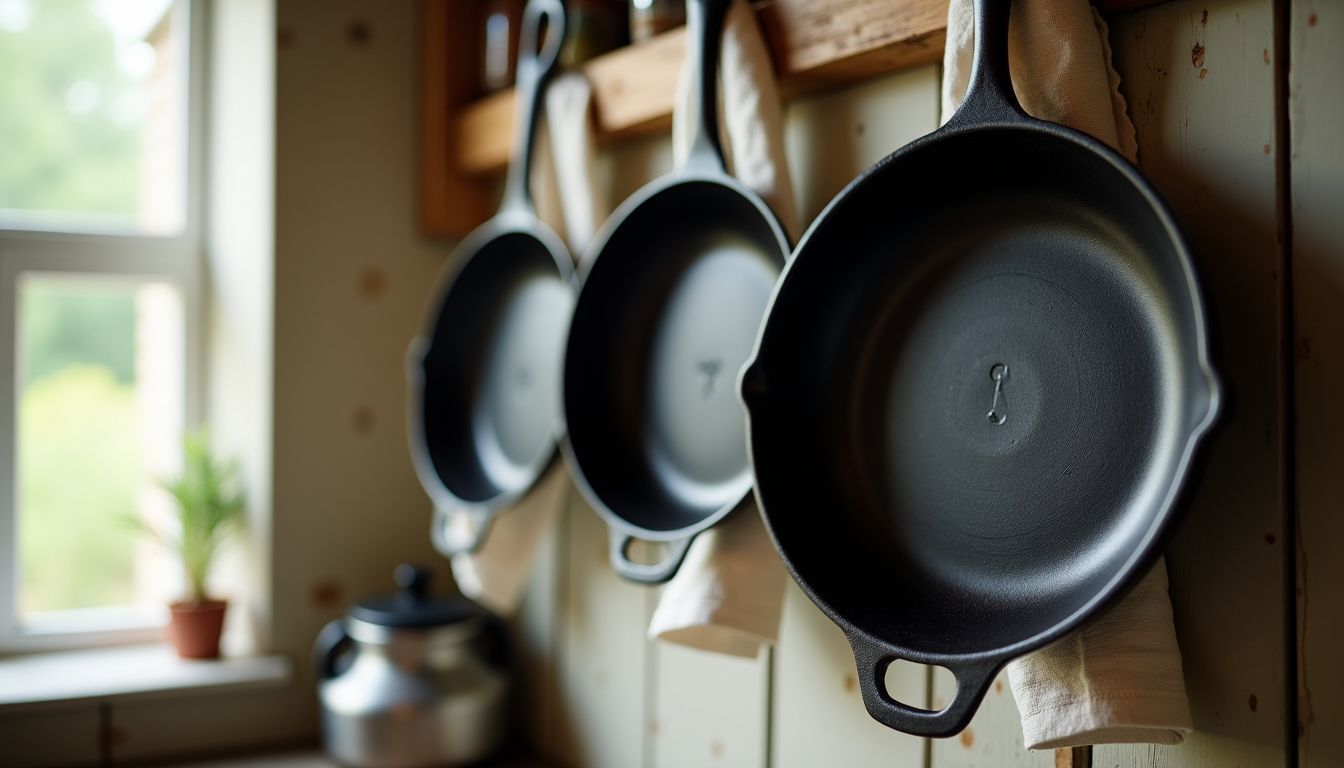
Storing a cast iron skillet right keeps it dry and rust-free. After cleaning and oiling, cover the cooking area with a paper towel. This step absorbs any leftover moisture. Then, find a safe spot to hang the skillet or stack it with paper towels in between if you have more pans.
This method prevents scratches and maintains the nonstick surface.
People often overlook proper storage, but it’s vital for your cookware’s lifespan. Ensure your storage space is dry to avoid rust forming on your skillet. With these steps, your cast iron cookware stays ready for your next cooking adventure without any extra fuss.
Conclusion

Cleaning a cast iron skillet keeps it in top shape and makes your cooking better. Use warm water, a pan scraper, and a little soap to get the job done. Dry it well and apply some oil to protect it from rust.
This way, you keep your skillet ready for the next meal. Taking care of your cast iron cookware is easy once you know how.
FAQs
1. What is the best way to clean a cast iron skillet?
The most effective method for cleaning a cast iron skillet involves using hot water and coarse or kosher salt. This combination helps remove stuck-on food without damaging the nonstick surface of your pan.
2. How can I remove rust from my rusty cast iron pan?
For rust removal, you may use steel wool or a chainmail scrubber along with some vegetable oil or canola oil. After scrubbing, rinse it with boiling water then dry it thoroughly on the stove to prevent further rusting.
3. Is there any special maintenance needed for my cast iron cookware?
Yes, regular seasoning of your cast iron cookware is crucial for its maintenance and longevity. You can season your pan by applying a thin layer of flaxseed oil or other cooking oils, then heating it on the stove until it smokes to create a nonstick surface.
4. Can I use aluminum foil instead of steel wool to clean my dutch oven?
While aluminum foil can be used in place of steel wool for scraping off hard-to-remove food particles, care must be taken not to scratch the surface of your dutch oven as this could damage its seasoning.
5. How do I dry my cleaned cast-iron skillet after washing?
After washing and rinsing your skillet with hot water, place it back on the stove over medium heat until all moisture evaporates completely – this process is known as stove drying which aids in rust prevention.
References
- https://www.goodhousekeeping.com/home/cleaning/a46707/how-to-clean-cast-iron/ (2023-07-31)
- https://www.lodgecastiron.com/discover/cleaning-and-care/cast-iron/how-clean-cast-iron?srsltid=AfmBOorcNFjsRuzKx6_k2KiBtbQq6cm-33MV1cYMuD9jyoJz_LfOyHK4
- https://lancastercastiron.com/pages/how-to-clean-a-cast-iron-skillet?srsltid=AfmBOoodVCHVr5wPGOo5VLjG-0NecJJETMjCNq4UJbPfgHrQlK_Q6p_1
- https://www.allrecipes.com/article/how-to-season-clean-cast-iron/
- https://www.lodgecastiron.com/discover/cleaning-and-care/cast-iron/how-clean-cast-iron?srsltid=AfmBOorw5IbCxgtwk-19EPx0iEmCX4cFmnlM8LC7ZIl6Gwnz1_5ECFMP
- https://www.lodgecastiron.com/discover/cleaning-and-care/cast-iron/how-clean-cast-iron?srsltid=AfmBOop8yD_koYfycAA3dz8QUlIccrZs2eqOhmeNaDVJRC2C-mX_2QU9
- https://www.southernplate.com/how-to-clean-a-cast-iron-skillet/
- https://lancastercastiron.com/pages/how-to-clean-a-cast-iron-skillet?srsltid=AfmBOorWFe8MGZ5WVPwPf_W98QVV6-NUf3GS7wXJeaEXaU0jf0kcZ2Vi
- https://www.allrecipes.com/article/how-to-clean-rusted-cast-iron/ (2020-09-24)
- https://www.seriouseats.com/how-to-clean-maintain-cast-iron-pan-skillet-cookware
- https://www.allrecipes.com/article/cast-iron-cooking-mistakes/ (2020-07-18)
- https://www.southernliving.com/food/kitchen-assistant/can-you-use-soap-on-cast-iron?srsltid=AfmBOopPSROCgomEqCK56kIW2Huzq_ZUbyfiGPURuza3kV-IaeMxJUor (2024-11-24)
- https://www.gardenweb.com/discussions/2415711/boo-hoo-i-soaked-my-cast-iron-skillet (2010-05-21)

